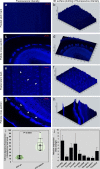Silencing of δ-aminolevulinic acid dehydratase via virus induced gene silencing promotes callose deposition in plant phloem
- PMID: 34994280
- PMCID: PMC9176224
- DOI: 10.1080/15592324.2021.2024733
Silencing of δ-aminolevulinic acid dehydratase via virus induced gene silencing promotes callose deposition in plant phloem
Abstract
The δ-aminolevulinic acid dehydratase (ALAD) enzyme is an intermediate in the biosynthetic pathway of tetrapyrroles. It combines two δ-aminolevulinic acid (δ-ALA) molecules to form the pyrrole, porphobilinogen, an important precursor for plant pigments involved in photosynthesis, respiration, light-sensing, and nutrient uptake. Our recent efforts showed that, in citrus, silencing of ALAD gene via Citrus tristeza virus-induced gene silencing, caused yellow spots and necrosis in leaves and in developing new shoots. Silencing of ALAD gene reduced leaf pigments and altered leaf metabolites. Moreover, total phenolic content, H2O2, and reactive oxygen species (ROS) increased, indicating that silencing of ALAD induced severe stress. Herein, we hypothesized that conditions including lower sucrose, elevated ROS, alteration of microRNA involved in RNAi regulatory protein Argonaute 1 (AGO1) and ROS lead to higher deposition of callose in phloem tissues. Using aniline blue staining and gene expression analysis of callose synthases, we showed significant deposition of callose in ALAD-silenced citrus.
Keywords: callose; citrus; citrus tristeza virus; phloem; virus-induced gene silencing; Δ‐aminolevulinic acid dehydratase.
Conflict of interest statement
No potential conflict of interest was reported by the author(s).
Figures



References
MeSH terms
Substances
LinkOut - more resources
Full Text Sources
